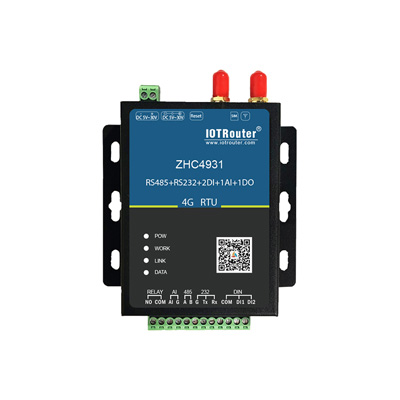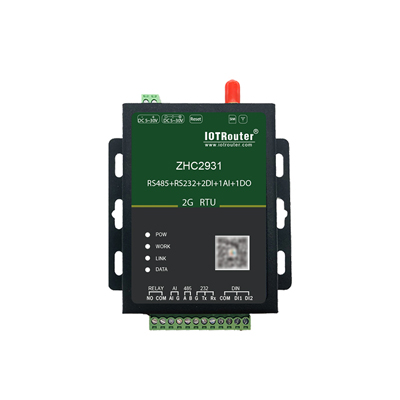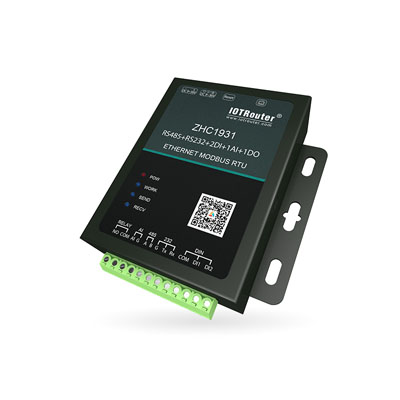Collecteur de valeurs à 3 voies de commutation
Provides 2DI (digital input signal), 1DO (digital output signal), in addition, also provides RS485 interface, which can be used to collect various temperature sensors, water pressure sensors, wind direction sensors, etc. It can be used in water pumping station monitoring, oil collection supervision, traffic street light supervision, remote meter reading and other industries.
Ce produit dispose de nombreux types de réseaux, notamment le réseau complet 4G, Ethernet et LoRa. Il possède également de nombreuses fonctions et peut répondre à la plupart des scénarios industriels. Il prend en charge Modbus RTU/TCP adaptatif, l'acquisition automatique et le rapport actif, l'acquisition de contrôle analogique 4~20mA, le rapport de seuil d'étalonnage automatique et d'autres fonctions spéciales. Il prend en charge les réseaux un à un et plusieurs à un, et la fenêtre d'interface du logiciel de configuration est visualisée pour permettre à l'utilisateur de connecter, déboguer et configurer les appareils sur site ou à distance.
4G network-3-way switching value collector
| Product model: ZHC493C
Type de réseau : Réseau 4G complet Number of interfaces: 2DI/1DO/1AI/1RS485 Product introduction: ZHC493C is a network IO product that supports 2 channels of dry (wet) node detection, 1 channel of relay (COM, NO, NC) output, 1 channel of analog quantity (current 4~20mA) detection, and 1 channel of serial port transparent transmission. , compatible with Modbus RTU/TCP protocol. With “remote control” as the core function and high ease of use, users can easily and quickly integrate it into their own systems to achieve remote and local control based on LTE and RS485. |
 |
| Product model: ZHC4931
Type de réseau : Réseau 4G complet Number of interfaces: 1RS485/232/2DI/1DO/1AI Product introduction: ZHC4931 is an industrial-grade 4G RTU, providing 1 serial port (RS485/RS232), 2 DI, 1 DO and 1 AI interface, supporting local logic processing operations, automatic collection and active reporting, Modbus RTU/TCP It has special functions such as self-adaptation, automatic calibration threshold reporting, configuration software docking, and wet and dry node IO detection. It supports one-to-one and many-to-one networks, and the configuration software interface window is visualized to enable users to connect on-site or remotely. |
 |
GPRS network-3-way switching value collector
| Product model: ZHC2931
Network type: GPRS network Number of interfaces: RS485/RS232/2DI/DO/AI Product introduction: ZHC2931 is an industrial-grade GPRS RTU, providing 1 serial port (RS485/RS232), 2 DI, 1 DO and 1 AI interface, supporting local logic processing operations, automatic collection and active reporting, Modbus RTU/TCP Adaptive, automatic calibration threshold reporting, configuration software docking, dry and wet node IO detection and other special functions support one-to-one and many-to-one networks, and the configuration software interface window is visualized |
 |
Ethernet-3-way switching value collector
| Product model: ZHC1931
Type de réseau : Ethernet Number of interfaces: RS485/RS232/2DI/DO/AI Product introduction: ZHC1931 is an industrial-grade RJ45 RTU that provides 1 RS485/232, 2 switching inputs, 1 switching output and 1 analog input interface, and supports 4 Socket, Modbus RTU/TCP adaptive, Local logic processing and calculation, automatic collection and proactive reporting, DO remote follow AI/DI, configuration cloud real-time monitoring of PLC, automatic acquisition of IP address |
 |
3-way switching value collector application
Industrial automation system – industrial automation production project, which can monitor the production chain data in real time, monitor the production line quantity through pulse counting, and connect the motor through the output interface for start and stop control.

Switching output programming
Switching output refers to digital output, which outputs 0 or 1 and is used to control switching signals such as external lights and relays. There are two types of switching output functions, one is output by byte; the other is output by bit.
Switch input
The switching value is a pair of contacts. There are two states between this pair of contacts, either connected or closed, or disconnected or disconnected. The information conveyed by this pair of contacts is a Switch. The switching value is divided into active or passive. When the active switching value is in the closed state, it will also provide a voltage drive.
The switching input is the connection channel between the PLC and the on-site detection components in the form of switching output (such as operation control buttons, travel switches, proximity switches, pressure relays, etc.). It converts the relevant signals reflecting the production process into the CPU unit. digital signals that can be received. In order to prevent various interference and high voltage from entering the PLC and affecting the reliability of the PLC operation, electrical isolation and anti-interference measures must be taken. In industrial sites, for various reasons, DC power supply or AC power supply may be used, and the PLC must provide corresponding DC input and AC input interfaces.
Switching output
Switching output is a function that enables the sensor to convert the sensed analog or digital signal into a switching signal and then output it.General switching output is realized through relays, such as single throw single pole, single throw double pole, double throw double pole, etc.
The signal sent by the switching sensor is a contact signal, which has two states: open and closed. For example, the liquid level sensor switch is a common switching sensor. When the liquid level sensor is lower than the set value, the liquid level sensor switch is open (or closed); when the liquid level sensor is higher than the set value, the switch is closed (or open)
For the control system, since the CPU is binary, each bit of data has two states: “0” and “1”. Therefore, the switch value can be represented by only one bit inside the CPU. For example, “0” is used to represent on. , use “1” to indicate off. Analog quantities usually require 8 to 16 bits to represent an analog quantity, depending on the accuracy. The most common analog quantity is 12 bits, that is, the accuracy is 2-12, and the highest accuracy is about 2.5 ten thousandths. Of course, in actual control systems, the accuracy of analog quantities is also limited by the accuracy of analog/digital converters and instruments, and it is usually impossible to reach such a high level.
Other recommendations:
· 8-channel analog collector
· 6-channel analog collector
· 4-channel analog collector
· 1 channel analog collector